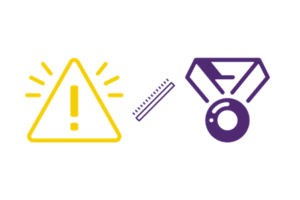Risk and Reward Ratio
Risk And Reward Ratio
The Forex risk reward ratio is a statistic that traders use to figure out how much they’re risking in exchange for a certain amount of profit. Traders typically use risk-to-reward ratios of 1:3, 1:2, or something similar.
Let’s imagine you’re trading with $10 and you’re putting everything into one deal. In this situation, your risk is $10, so we’ll use a coefficient of one. If you expect or prefer to receive a $30 payoff from your trade, your reward ratio coefficient is 3, because 30/10 = 3.
The risk reward ratio, on its own, does not give the trader much information unless it is combined with another statistic, the payout rate.
It is much easier to calculate whether your approach will be successful in the long run after the Forex risk reward ratio has been coupled with the payout rate. The following is the formula for determining the risk reward ratio with the payout rate:
P = (1+(X/Y)) x Z – 1
In the following paragraphs, we’ll look at what each of these symbols signifies and what the formula can accomplish for you in the long run. You’ll also discover when and how to use the risk reward ratio, as well as whether or not you should use it at all.

How does the Forex risk-reward ratio technique work?
Let’s talk about the formula we mentioned earlier. It’s a crucial factor to consider while attempting to maximize the risk-reward ratio. The following are the meanings of the symbols in the formula.P = success rate
- X = the average payment size
- Y = the average size of losses
- Z = payout rate
So, armed with this data, we can quickly determine our success rate based on our trading history.
Let’s say we made ten trades, two of which were unsuccessful and eight of which resulted in a profit. This indicates we had an 8/10 payout rate, which is 80%, or 0.8. Although we may believe the risk/reward ratio is 1:14, this is not always the case.
Assume the total payoff was $4000, which means our average payout is $500 (since 4000/8 = 500).

Let’s imagine our net loss was $2000 as a result of bad trades. Due to the fact that 2000/2 = 1000, the average loss is $1000.
Let’s now apply all of this knowledge to our formula.
P = (1 + 500/1000) x 0.8 – 1
This would result in a success rate of 0.2, or 20%. The good news is that this is a positive success rate, indicating that our technique is workable.
It is possible to apply our Forex risk reward ratio as long as it yields a positive success rate, but as you can see, the ratio in our example was not necessarily what you saw.
According to our calculations, the risk-to-reward ratio was 1:0.5, which may not appear to be a good choice. However, as you can see, even the lowest risk-to-reward ratios can be profitable in the long run.
When does the risk-to-reward ratio come into play?
The risk reward ratio may appear to be nothing more than a collection of figures based on your trading patterns, but how can you use it to your trading?
Thankfully, in Forex trading, the risk-reward ratio precisely correlates into the types of orders you can put in the market.
Stop orders are something you may have heard of before. It’s a sort of order that allows traders to close or “stop” their trades when an asset hits a certain price level.
“Stop loss” and “take profit” orders are the most popular types of stop orders. They typically do what their names suggest. The stop loss order will terminate your trade once you’ve lost a certain amount of money, while the take profit order will end it once you’ve made a certain amount of money.
Now, why are these order kinds significant when it comes to risk-reward ratios?
The rationale for this is because these order types can be used to visualize any Forex risk reward approach. Let’s pretend that the AUD/JPY exchange rate is 100.00. You obtain some useful information, which indicates that the pair’s exchange rate might rise to 150.00 or fall to 70.00.

The majority of traders would start by opening their trades and setting the following orders. Take a profit at 140.00 and place a stop loss at 80.00. This is primarily due to the fact that the greatest and lowest points of projections are notoriously difficult to reach.
We’d be in a unique situation if we placed this kind of order. We can readily observe that the risk-to-reward ratio is 1:2 if we use our Forex risk-to-reward calculator. Why? It’s that easy.
Since the conversion rate is 100 and we want a payout of 140, we’re asking for 40 points, to put it another way. However, we are also willing to exit the market at 80 points, implying a total loss of 20 points. We just need to divide the losing points by the gaining points to get the risk/reward ratio we’re searching for. In this instance, the ratio is 1:2.


The key takeaways from the risk-reward ratio in FX
The risk reward ratio is a useful indicator to have, but it must be tailored to each trader’s trading history, strategy, and overall performance. If your trading method has a negative success record, for example, it may be wiser to adjust the approach and focus on a much lower risk reward ratio as you continue to experiment.
Because of the unique order placements that financial markets give, the risk reward ratio can be directly applied. Stop orders, also known as “stop loss” and “take profit” orders, are used to place these types of orders. You must accomplish the following in order to apply your risk reward ratio trading method to actual deals.
Let’s say you have a 1:3 ratio. The “1” represents what you are prepared to give up, while the “3” represents what you desire to gain. So, if you want a 15% payoff, you should be willing to lose at least 5% of your money. This scales according to your ratio, making it simple to customize.
Because the market is continually changing and the trader must move with it, the risk reward ratio is not a stable metric. Keeping a strategy just because it has a high payout rate does not guarantee that it will endure indefinitely.
Furthermore, the ratio must be backed up by detailed technical research, because merely possessing the ratio does not guarantee that the trade will succeed every time.
Risk-to-reward ratios: Frequently Asked Questions
The best risk-to-reward ratio does not exist. Everything is different depending on the trader, asset, instrument, and market trend. In some circumstances, a risk-to-reward ratio of 1:0.25 may be optimal, whereas in others, a risk-to-reward ratio of 1:5 or even 1:10 may be appropriate.
In most circumstances, the risk-to-reward ratio will be determined by your study of the amount of profit you can make from a single deal.
Because markets are always changing, a strategy can endure a day, a week, a month, or even a year. There is no such thing as a 100 percent guarantee, which is why foreign exchange trading is so dangerous. Any Forex strategy with a high risk-to-reward ratio, no matter how effective in the past, will eventually fail. Unfortunately, there are few ways to forecast this, which is why skilled traders recommend minimizing risk.
Should I calculate my ratio before or after trading for a while?
It is recommended that you have at least a little bit of trading experience before choosing your go-to risk reward Forex ratio. The experience helps you look at your background, calculate your strategy success rate, and then deduce just how much you have risked and gained in total. Creating a ratio from that should be quite easy, giving you a more clear picture rather than guessing from the start.
Yes, you can use a Forex risk reward ratio calculator with your trading software, but the calculations are usually simple enough to accomplish manually.
